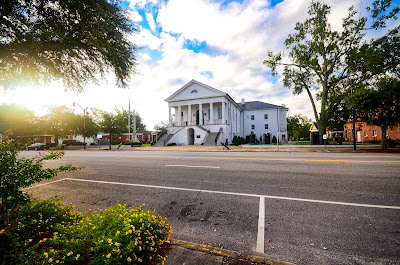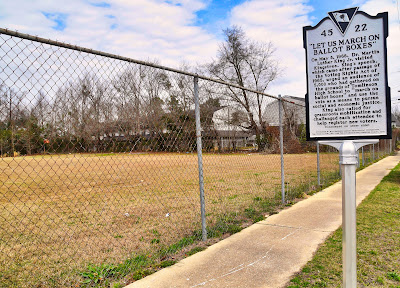Imagine you are assigned to design a postcard. What image would you use to depict the essence of Kingstree's best qualities? Participants in the two public-input sessions hosted by Main Street, South Carolina, on February 15 brainstormed a number of postcard-quality images. Not surprisingly, Black River was the first image mentioned at both sessions.
Black River on a calm evening at Gilland Park, still known to many as the Scout Cabin.
Black River has long been an image central to the community. Way back in June, 1910, the local correspondent to The State newspaper entered Kingstree in that paper's contest for "The Best Town in South Carolina." In his entry, he noted, "The best stream in the world for for fishing–Black River–runs through the corporate limits of town." The State responded by printing, "When attention is directed to Black River, full of bream, flowing through Kingstree, perhaps it is not necessary to mention anything else."
Modern day residents, however, insist Black River provides more to the community than excellent fishing. Some say the "Sportsman's Paradise" brand Kingstree has used for many years is too narrow. They believe "Sportsman's Paradise" is too closely associated with hunting and fishing and doesn't adequately convey the availability of kayaking, canoeing, and the desire for nature trails.
Other suggestions for postcards included both the Williamsburg County Courthouse and the old Carnegie Library building, now home to the Williamsburgh Historical Museum. Built in 1823, the courthouse on Main Street has seen a number of renovations, the latest about four years ago. Designed by Robert Mills, it is one of the few Mills' courthouses in South Carolina where court is still held. The library, built in 1917, on Hampton Avenue is one of 1,689 libraries in the United States constructed with funds donated by Scottish businessman and philanthropist Andrew Carnegie. It served library patrons until 2000 when a new library was built on Jackson Street.
The Williamsburg County Courthouse on Main Street in Kingstree.
The Williamsburgh Museum on the corner of Hampton Avenue and Mill Street.
Architect Randy Wilson, who conducted the exercise at the Main Street meeting, said he doubts if more than handful of communities throughout the country are fortunate enough to have both a Robert Mills building and a Carnegie library. Mills, the first federal architect, is best known for designing the Washington Monument, and U.S. Treasury Building in Washington, DC, the Fireproof Building in Charleston, and numerous courthouses and jails in his native South Carolina. In 1883, the second floor of our courthouse burned; however, the first floor was unharmed, a testament to Mills' fireproof construction.
Participants considered the Kingstree Depot, built in 1905, another location worthy of a postcard. The depot, during the early 1900s, was a hub of activity as farmers shipped agricultural products to northern markets every day. Residents from many areas near Kingstree caught the train here for business or social visits to larger cities. Today, the Town of Kingstree owns the depot, and it serves as the Main Street, Kingstree office. The Front Porch restaurant also calls the depot home as it once again becomes a hub for downtown activities.
The Kingstree Depot, Summer 2017.
The historical marker at the site of Dr. Martin Luther King, Jr.'s 1966 speech.
The old Tomlinson High School football field, the scene of Dr. Martin Luther King, Jr.'s May 8, 1966, speech, was also suggested. Fifty years later, on May 8, 2016, an historical marker was unveiled at the site. Dr. King's 1966 speech has become known as the "March on Ballot Boxes" speech, as he encouraged South Carolina's black citizens to exercise their right to vote, which had been guaranteed by the federal Voting Rights Act of 1965.
Another image suggested to depict Kingstree's best qualities was that of "family." Participants described Kingstree as a place of family fun, values, quiet, friendly people–a place to get back to basics in which families have a love of community and small town living.
Families and friends gathered last July at the depot to celebrate the first Kingstree Live event.
Residents show their friendliness and hospitality by waving at the passing AMTRAK.
AMTRAK stops four times daily in Kingstree.
Last August, families again gathered, this time at the recreation center,
with friends and visitors to watch the total eclipse of the sun.
Kingstree's historic homes were another suggestion. Three Kingstree homes are on the National Register for Historic Places: The M.F. Heller house on N. Academy Street; the Scott house on Live Oak Avenue, and the Col. J.G. Pressley house on W. Academy Street. Randy Wilson noted that there are other older homes in Kingstree which also provide a feeling for the town's historic roots. The Heller house recently opened its doors as the Heller House Inn bed and breakfast.
The inviting front porch of the Heller House Inn.
Although not on the National Register, these Live Oak Ave. homes
exhibit Kingstree's Southern charm.
All photos by Linda Brown
Another question posed to citizens attending the February 15 meetings was what words or phrases they'd use to put on their postcards to entice recipients to visit the area. Back in 1910, "Greater Kingstree" was the slogan used. Every improvement was hailed as working toward a "Greater Kngstree." Among the words suggested on February 15 were: down home, friendly, and historic. Two phrases offered were "Family-friendly smiling faces," and "Kingstree is in the middle of nowhere but at the center of everything." Randy pointed out that in looking at a map, he, too, had noticed that Kingstree is within an hour or so's drive of Moncks Corner, Sumter, Florence, Conway, and Georgetown, while Manning, Andrews, Hemingway, Johnsonville, St. Stephen, and Lake City can be reached in 30 minutes or less. One participant at the morning session said she had moved to Kingstree specifically because of its accessibility to other areas.










No comments:
Post a Comment